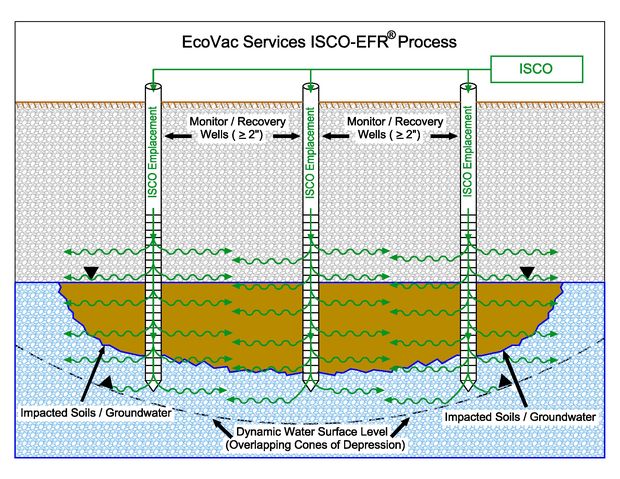Search: Site This Page
(405) 360-1552

| Ecovac Services / Technologies / |
In Situ Chemical Oxidation (ISCO-EFR®)
ISCO-EFR® is EcoVac’s proprietary technology combining multi phase / dual phase extraction (MPE/DPE) with in situ chemical oxidation (ISCO). This unique approach has decreased contaminant levels relative to corrective action levels by 80 to 100% in nearly all applications. This process targets sites with dissolved groundwater contamination from chlorinated or non-chlorinated organic compounds for effective environmental groundwater remediation.
Advantages of ISCO-EFR®over other remediation options include limited generation of waste material, safe injection protocol, plume containment by hydraulic and vacuum control, minimal site disturbance, and reduced cleanup time. These advantages result in savings on material, monitoring, and maintenance.
A complete understanding of the site geology, hydrogeology, and geochemistry, as well as the contaminant profile, is necessary for successful ISCO-EFR®. EcoVac’s EFR® technology is used to pilot test the site to ascertain the hydraulic properties of the subsurface and determine the chemical oxidant injection volumes, concentrations, and optimal injection well sequencing for injection of the chemical oxidant. EcoVac utilizes our internal treatability/research lab to determine natural oxidant demand (NOD) and conduct column studies to determine the compatibility of the oxidant and its activation chemistry with the site soil and groundwater and subsequently, test the site-derived media (soil and groundwater) to estimate the amount of oxidant needed to completely mineralize the contaminants. EcoVac Services works closely with FMC Corporation to develop a site-specific approach on a case-by-case basis where sodium persulfate oxidant is utilized.
A problem in using traditional ISCO methods is getting enough oxidant in contact with the contamination. "Chemical oxidants may not be able to penetrate low permeability homogeneous soils or horizons in heterogeneous soils that contain the bulk of petroleum contaminant mass" (U.S. EPA 2004, page XIII-2). The MPE/DPE component of ISCO-EFR® is utilized to dewater the area of concern prior to the injection of the chemical oxidant and create direct and undiluted oxidant contact with the impacted zone. The MPE/DPE process facilitates maximum horizontal distribution of the oxidant. Post-injection aquifer rebound provides vertical distribution of the injected chemical oxidant solution.
ISCO-EFR® does not create plume displacement that is common with most types of subsurface injection. "An issue that must be resolved when assessing treatment effectiveness is the role of displacement of contaminated water away from the injection points. Depending on sampling locations observed, post-injection declines might reflect the displacement of contaminated water rather than actual contaminant mass destruction" (ITRC 2005, page 56). ISCO-EFR® facilitates maximum distribution and contact of chemical oxidants with the contaminant under controlled conditions, essential for effective remediation. This approach captures fugitive vapors while also reducing the chance of rebound of dissolved phase groundwater concentrations. High pressure injection or direct-push injection points, which can lead to undesired displacement of dissolved or vapor phase contaminants, are not components ISCO-EFR®.
Solid compounds used for ISCO are mixed into solution prior to injection. Some injection methods require oxidants to be diluted to 10% or less, which greatly reduces effectiveness. At that dilution, it is difficult to inject enough active ingredients into low permeable soils to produce the desired cleanup. EcoVac Services introduces oxidants in a 25% to 35% aqueous solution and will not be diluted by groundwater contained in the aquifer, as the groundwater will be dewatered/removed in advance of oxidant emplacement.
EcoVac’s chemical oxidant of choice is activated sodium persulfate. Activated sodium persulfate is the emerging oxidant of choice for chemical oxidation because of its ability to treat a wide range of contaminants. When properly activated, sodium persulfate provides an unmatched combination of oxidative power and control that can be delivered both safely and cost efficiently. Successful pilot and full-scale field applications of activated sodium persulfate have been performed in over 30 states by EcoVac Services (and others) utilizing Klozur™ Activated Persulfate product, manufactured by FMC Corporation. FMC Corporation is a multi-billion dollar chemical company that has been a pioneer in applied oxidation chemistry for 60 years, including having developed patent pending activation chemistries for Klozur™ Activated Persulfate. Field applications have demonstrated the ability of Klozur™ Activated Persulfate to treat a wide range of contaminants including; chlorinated ethenes (PCE, TCE, DCE, and vinyl chloride), chlorinated ethanes (1,1,1-TCA, DCA, vinyl chloride), chlorinated methanes (carbon tetrachloride, chloroform), polyaromatic hydrocarbons (PAH’s), petroleum hydrocarbons, BTEX, MTBE and 1,4-dioxane.
Klozur™ Activated Persulfate generates the sulfate radical, (SO4 *-), one of the strongest and most versatile oxidizing species available, capable of destroying many of the most recalcitrant compounds. Additional Klozur™ Activated Persulfate information can be found at http://www.envsolutions.fmc.com.

